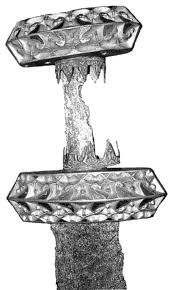Posts: 828 Location: Nykøbing Falster, Denmark
Sun 28 May, 2017 9:55 am
A Danish article on two K-type swords from Nationalmuseet is available on academia.edu.
Pentz, Peter (2012)
To vikingesværd med karolingisk planteornamentik i Nationalmuseets samlinger.
Source:
http://www.academia.edu/29992988/to_vikingesv%C3%A6rd.pdf
It has an English summery (page 144-46).
From the old Danish viking age territory only 3 K-type swords have been found.
Two of those are from Hedeby and then one from southern Sjælland - possibly an old unprofessional dig from the mid 19th century from the mound "Møllebanken" at Stårby in Øster Egesborg Parish..
The article gives good pictures (incl. x-ray) of the Møllebanken/Stårby/Øster Egesborg sword and later in the article also pictures or engravings of other k-type swords.
Nationalmuseet also have two Irish swords from Kilmainham, which were acquired by Worsaae in Dublin 1846-1847.
The Møllebanken sword and one of the Kilmainham swords now in Denmark is part of an exclusive
little group of 14 k-type swords with plant ornamentation!
2 are from Old Danish territory (Møllebanken and one of the Hedeby swords)
2 are from Norway (Gjersvik, Hordaland & Gravråk Trondheim)
3 are from Ireland (including the one acquired by Worsaae)
2 from Frankish territory (Liepe in Germany and Elst in the Netherlands)
1 unknown find place (in the
Wallace collection, London).
That is some interesting distribution!
4 of this group of swords have inscriptions with latin letters on the upper part of the cross guard.
Two of them are Irish, 1 is Norwegian and 1 from Germany.
A sword from Kilmainham (now in Dublin) has "hartolfa" on the guard.
A sword from Ballinderry crannog has "hiltipreht" as has the sword from Liepe. Also the Ballinderry crannog sword has an +ulfberht+ inscription on the blade.
The author states that one of the swords should have the inscription "hlither" and that must be the Norwegian sword from Gravråk, but to my eyes it actually looks more like "Hiltipreht" (?).
The Norwegian sword from Gjersvik doesn't have a name on the guard, but is also an inscribed +ulfberht+ like the Ballinderry crannog sword. So none of them are +ulfberh+t examples.
Hiltipreht must be equivalent to Hildebrecht in modern German. Hiltipreht likely a variant of Hildiberht meaning "Battle-Shining".
Hartolfa is interesting of we have a name retaining an older iron age Germanic masculine -a ending; perhaps Hart-olf-a? Could this be a contraction of "Hard/strong-Wolf" as a masculine personal name?
Hlither could have the first part the element ON hlíð or OHG (h)lita meaning "slope, hillside" in some kind of contractive name-combination.
I would say that this is much more like personal names. The amount of Hiltipreht - 2(3?) out of 4 - indicates it is far more likely that the name inscribed is the name of the giver, rather than the receiver.
The plant ornamentation is apparently predominately vine ornamentation on the swords (the Hedeby sword an exception) and must be Carolingian (& Christian) art decoration.
Combining sword type and vine-ornamentation early part of 800 AD seems to be holding as a dating.
So these swords is in my opinion gifts from someone to possible allies OR to warriors that have served in a comitatus under the named individual in question?
Another possibility is that Hiltipreht was a very common name (much less likely).
